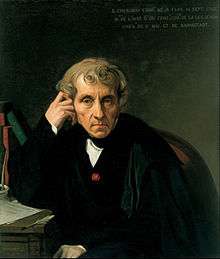Pimmalione
| Luigi Cherubini |
|---|
 |
|
Operas
|
Pimmalione (Pygmalion) is an opera in one act by Luigi Cherubini, first performed at the Théâtre des Tuileries, Paris on 30 November 1809. The libretto is an adaptation by Stefano Vestris[1] of Antonio Simone Sografi's Italian translation of the text Jean-Jacques Rousseau wrote for his scène lyrique Pygmalion (1770). It is based on the Classical legend of the sculptor Pygmalion.
Pimmalione was specially commissioned by the Emperor Napoleon Bonaparte to show off the talents of two of his favourite singers, the famous castrato Girolamo Crescentini and the contralto Giuseppina Grassini (who had been Napoleon's lover). It was first given in a private performance at the emperor's palace, Les Tuileries. Napoleon was delighted with the work and offered Cherubini a large reward and a commission for another piece.
Roles
| Role | Voice type[2] | Premiere cast, 1 September 1810[3] |
|---|---|---|
| Pimmalione (Pygmalion) | soprano (castrato) | Girolamo Crescentini |
| Galatea | soprano | Louise Augustine Hymm[4] |
| Venere (Venus) | contralto[5] | Giuseppina Grassini |
| Amore (Cupid) | boy soprano[6] | Carlo Vestris[7] |
Synopsis
The sculptor Pygmalion falls in love with his own work, a statue of Galatea. He prays to the gods of love Venus and Cupid to release him from his passion. While he sleeps, Galatea's statue comes to life, dances and falls in love with Pygmalion. Pygmalion and Galatea celebrate their wedding in the palace of Venus.
References
Notes
- ↑ Stefano Vestris, "a stage poet of no ability", was a member of the famous Italian-French theatrical family which had originated with his father, dancer Gaétan Vestris, and later shone with his brother Auguste Vestris, also a ballet étoile (Henry Sutherland Edwards, History of the Opera, from its Origin in Italy to the present Time, Londra, Allen, 1862, I, p. 302; accessible for free online at Google Books).
- ↑ According to Mellace.
- ↑ According to Carli Ballola.
- ↑ Shortly to become commonly known as 'Madame Albert', after marrying the dancer François-Ferdinand Decombe, called Albert (Article: Albert, Augustine, in Spire Pitou, The Paris Opéra. An Encyclopedia of Operas, Ballets, Composers, and Performers – Rococo and Romantic, 1715-1815, Westport/London, Greenwood Press, 1985, p. 17, ISBN 0-313-24394-8).
- ↑ The voice type 'contralto' is stated by Mellace, whereas according to the website of the Bibliothèque nationale de France all the vocal parts are notated on the score in the soprano clef (Ut 1). Which is, however, scarcely surprising, given that in French vocal music the alto clef was generally used only for the haute-contre (high tenor) voice.
- ↑ "...appearance in the role of Cupid of a 12-year-old Carlo Vestris (a treeble, therefore; not a sopranist as elsewhere reported)..." (Carli Ballola).
- ↑ Charles (Carlo) Vestris was the son of the librettist of Pimmalione; he was later to become the last celebrated dancer of the Vestris family who appeared on the stage (H. Sutherland Edwards, cited above).
Sources
- (Italian) Carli Ballola, Giovanni, Cherubini: L'uomo. La musica, Milan, Bompiani, 2015, ISBN 978-88-58-77183-9.
- Deane, Basil, Cherubini, New York, Oxford University Press, 1965
- (Italian) Mellace, Raffaele, Pimmalione, in Piero Gelli (ed), Dizionario dell'opera 2008, Milan, Baldini Castoldi Dalai, 2007, pp. 1021-1022, ISBN 978-88-6073-184-5 (the article is reproduced at Opera Manager)